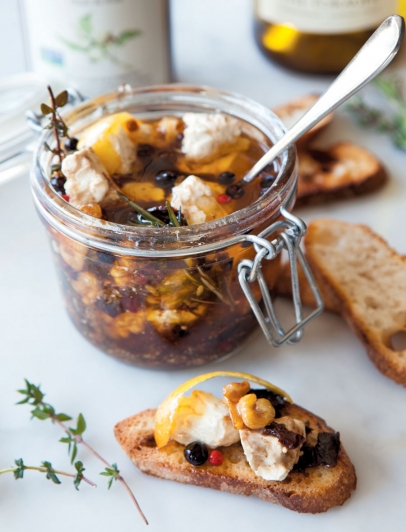The ancient practice of Marinating Cheeses
Today It’s All About Adding Flavor
Storing cheese and other foods in olive oil has long been standard practice in Mediterranean households. In Italian, the technique is referred to as preserving sott’olio. In French, à l’huile. In Spanish, en aciete de oliva.
A covering of oil acts as a preservative, sealing the stored food away from air that can cause oxidation, mold and decay. The technique was developed out of necessity in the days before refrigeration, but remains helpful today, especially in warm climates. It is also a great way to add flavor.
Marinated cheese is a versatile item to have on hand, adding interest to an antipasti platter or spicing up pasta dishes, salads, meats or breads. Any fresh, semi-firm cheese lends itself to this preparation, with goat and sheep cheeses most commonly used. Fresh mozzarella is also greatly enhanced by marinating. Marinades can be as simple as olive oil and herbs, or as complex as your imagination allows.
Two local cheesemakers, Laura Chenel’s Chevre and a relative newcomer to the scene, Chevoo, both produce excellent marinated cheeses ready to serve that are available at local markets. Laura Chenel’s offers two versions of a marinated goat-milk cheese: Cabecou, marinated with herbs, and Spicy Cabecou, with a little bit of a kick.
Chevoo was born when Australians Susan and Gerard Tuck and their three daughters moved to Sonoma County and missed the marinated goat cheeses that had been a staple on their table back home. The Tucks and their team hand-blend high-quality chèvre with different combinations of spices, herbs, chiles and pollens, then pack them into jars and cover them with extra-virgin olive oil that has been infused with crushed botanicals for up to eight weeks. Currently they offer California Dill Pollen & Garlic; Smoked Sea Salt & Rosemary; and Aleppo-Urfa Chili & Lemon. Rumor has it there are more flavors in the works.
It’s also fun and easy to make your own unique version of marinated cheeses. There are no rules. If you like the flavors, go for it. Don’t let anyone tell you what’s right or wrong. If it fails, try another version.
For the recipe below, I decided to go with a California theme, blending a handful of the tastes and smells I associate with this area. I started with a sheep milk feta sourced from San Rafael’s Marin Cheese Company. Then I mixed things up a bit, using La Tourangelle’s walnut oil rather than an olive oil. This Berkeley-based producer makes a wide range of high-quality cooking and facial oils, using ancient French methods. The walnut oil has an unmistakable taste that complements, but does not overwhelm, the other flavorings.
For the other additions, I chose bay laurel leaves—reminiscent of a rainy day walk through the woods of Point Reyes; fennel and anise seed—the overgrown yard I once had where my schnauzer loved to chew the stalks of wild fennel (a natural dog breath freshener); smoky sweet ancho chilies—a long-gone favorite Mexican restaurant; juniper berries—hiking on Mount Tam; and rosemary, thyme and lemons—found in many home gardens in Marin.
My choice for a local wine pairing would be Pey-Marin Vineyard’s The Forager Chardonnay, produced from grapes sourced from various vineyards located along the chilly Sonoma Coast. This fruit-forward and subtly spicy wine allows the flavors of the cheese to shine.





